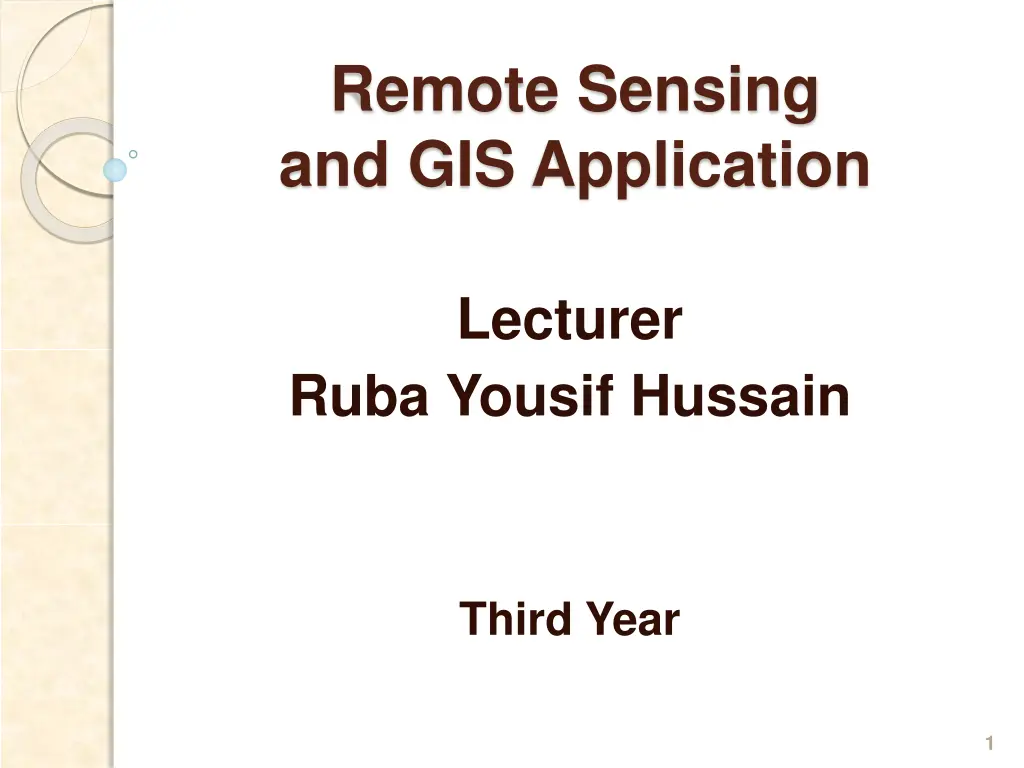
Enhancing Spatial Imagery using GIS and Remote Sensing Techniques
Learn about spatial enhancement of imagery and convolution filtering in ArcGIS conducted by lecturer Ruba Yousif Hussain for third-year students. Explore resampling methods and tutorials for applying spatial enhancement using ArcGIS tools.
Download Presentation

Please find below an Image/Link to download the presentation.
The content on the website is provided AS IS for your information and personal use only. It may not be sold, licensed, or shared on other websites without obtaining consent from the author. If you encounter any issues during the download, it is possible that the publisher has removed the file from their server.
You are allowed to download the files provided on this website for personal or commercial use, subject to the condition that they are used lawfully. All files are the property of their respective owners.
The content on the website is provided AS IS for your information and personal use only. It may not be sold, licensed, or shared on other websites without obtaining consent from the author.
E N D
Presentation Transcript
Remote Sensing and GIS Application Lecturer Ruba Yousif Hussain Third Year 1
Remote Sensing and GIS Application Lecturer Third Year Ruba Yousif Hussain Spatial Enhancement of Imagery Spatial Enhancement changes the individual pixels based on its neighbors. Resampling Method 1. Nearest Neighbor The pixel is assigned the value of the cell closet to it. It does not alter the value of the input cells. 2. Bilinear Interpolation Bilinear Interpolation creates a smooth looking result. Bilinear interpolation uses the value of the four nearest input cell centers to determine the value on the output raster. The new value for the output cell is a weighted average of these four values, adjusted to account for their distance from the center of the output cell. 3. Cubic Convolution Cubic Convolution creates a sharper looking image. Cubic convolution is similar to bilinear interpolation except that the weighted average is calculated from the 16 nearest input cell centers and their values. 4. Majority The pixel is assigned the most common value within a specific filter window smoothing the image. 2
Remote Sensing and GIS Application Lecturer Third Year Ruba Yousif Hussain Convolution Filtering in ArcGIS Convolution Filtering is the process of averaging small sets of neighboring pixels across an image, and it is used to change the spatial frequency characteristics of an image. When using the Spatial Analyst Tools in ArcGIS , a new permanent file will result. Original image unaltered file will still be available and the new file added to ArcMap. Filter Tool Two type of filter operation to perform : 1. Low pass smoothes Traverses a low pass 3-by-3 filter over the raster. This option smooths the entire input raster and reduces the significance of anomalous cells.This is the default. 2. High pass enhances edges. Traverses a high pass 3-by-3 filter over the raster. This option enhanced the edges of subdued features in a raster. 3
Remote Sensing and GIS Application Lecturer Third Year Ruba Yousif Hussain Spatial Enhancement of Imagery Laboratory Spatial Enhancement of Imagery Purpose Spatial Enhancement of Imagery using resampling Application ArcGIS Tutorial Resampling a- Resampling using Image Analysis Window Open Image Analysis Window Test Resampling methods 4
Remote Sensing and GIS Application Lecturer Third Year Ruba Yousif Hussain b- Resampling using ArcToolbox 5
Remote Sensing and GIS Application Lecturer Third Year Ruba Yousif Hussain 6






















